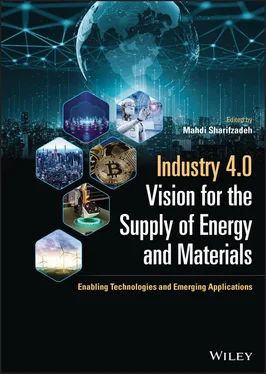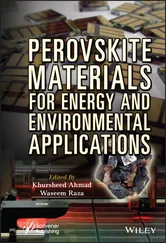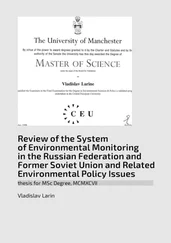Industry 4.0 Vision for the Supply of Energy and Materials
Здесь есть возможность читать онлайн «Industry 4.0 Vision for the Supply of Energy and Materials» — ознакомительный отрывок электронной книги совершенно бесплатно, а после прочтения отрывка купить полную версию. В некоторых случаях можно слушать аудио, скачать через торрент в формате fb2 и присутствует краткое содержание. Жанр: unrecognised, на английском языке. Описание произведения, (предисловие) а так же отзывы посетителей доступны на портале библиотеки ЛибКат.
- Название:Industry 4.0 Vision for the Supply of Energy and Materials
- Автор:
- Жанр:
- Год:неизвестен
- ISBN:нет данных
- Рейтинг книги:4 / 5. Голосов: 1
-
Избранное:Добавить в избранное
- Отзывы:
-
Ваша оценка:
- 80
- 1
- 2
- 3
- 4
- 5
Industry 4.0 Vision for the Supply of Energy and Materials: краткое содержание, описание и аннотация
Предлагаем к чтению аннотацию, описание, краткое содержание или предисловие (зависит от того, что написал сам автор книги «Industry 4.0 Vision for the Supply of Energy and Materials»). Если вы не нашли необходимую информацию о книге — напишите в комментариях, мы постараемся отыскать её.
Explore the impact of Industry 4.0 technologies on the supply chain with this authoritative text written by a leader in his field Industry 4.0 Vision for the Supply of Energy and Materials,
Industry 4.0 Vision for the Supply of Energy and Materials
Industry 4.0 Vision for the Supply of Energy and Materials — читать онлайн ознакомительный отрывок
Ниже представлен текст книги, разбитый по страницам. Система сохранения места последней прочитанной страницы, позволяет с удобством читать онлайн бесплатно книгу «Industry 4.0 Vision for the Supply of Energy and Materials», без необходимости каждый раз заново искать на чём Вы остановились. Поставьте закладку, и сможете в любой момент перейти на страницу, на которой закончили чтение.
Интервал:
Закладка:
Long range (LORA).As a promising wireless standard for IoT use cases, LoRa is a physical layer technology for LPWAN developed by Semtech Corporation [98]. It operates in an unlicensed band and offers seamless connection with wide range deployment (several kilometers) and minimum investment and maintenance costs. LoRa has adopted enhanced modulation and optimum network protocols for finite energy sensors.
LoRa modulation achieves bidirectional communication through a proprietary spread spectrum technique in the sub-GHz frequency band: the chirp spread spectrum (CSS) scheme [99, 100]. This technique in LoRa generates a narrowband (NB) signal and spreads it over a wider channel bandwidth to provide a signal with wide bandwidth. 4This results in larger signal-to-noise ratio where the received signal is difficult to be jammed, making it resilient to communication channel degradation arising from Doppler effect, multipath fading, and a high level of noise [101, 102]. Importantly, LoRa modulation contributes to greater maximum coupling loss (MCL) compared with existing sub-GHz communications and enlarges the capacity of the network as well as extending the coverage distance [103]. LoRa modulation utilizes variable spreading factors (SF) to balance between the data rate and range: a lower SF offers higher data rate at the cost of shorter range; by contrast, a high SF provides a low data rate, implying a larger range. Depending on the SF and channel bandwidth, a LoRa network achieves the data rate of 22 bps–50 kbps. In addition to adaptive data rates, spreading enables the simultaneous transmission of multiple spread signals over identical frequency channel. Therefore, LoRa base stations could simultaneously receive the transmitted messages with different SFs [104]. The largest length of payload for every message is 243 bytes [93].
LoRa’s performance has been verified in multiple countries on smart meters, traffic monitoring, and smart health care [105, 106]. It also optimizes the protocol for power-restricted sensors and introduces three modes of operation for LoRa-based terminals in IoT environments. According to various application scenarios, these modes of operation identify data-receiving windows for each class of end devices and determine how these terminals communicate with the network. LoRa technology utilizes AES-128 for data encryption to ensure channel security.
LoRaWAN.As LoRa is mainly focuses on physical layer and its specification for connection of devices to infrastructures, LoRaWAN focuses on MAC protocol [107]. It is maintained by the LoRa Alliance and acts as the protocol that manages LPWAN communication from end devices to gateways. LoRaWAN is based on the pure Additive Links Online Hawaii Area (ALOHA) protocol [49] to increases the success rate of the reception of the messages. This is because in ALOHA all base stations within the range could receive each message sent by an end device.
NB-IoT.Standardized by the Third Generation Partnership Project (3GPP) as a narrowband IoT communication technology [92], the NB-IoT is built on the prevailing LTE functionalities and works on the licensed frequency bands. Since NB-IoT could coexist with GSM and LTE, its deployment is rather simple, particularly in the existing LTE networks. The protocol of NB-IoT is derived from the LTE protocol; however, many LTE functionalities are reduced to make it simple and more suited to IoT applications. Thus, from the perspective of a protocol stack, NB-IoT could be seen as a novel air interface built on LTE infrastructure. NB-IoT could deploy LTE backend systems and broadcast signals for all end apparatuses within a cell. To minimize battery (and resource) consumption of the end devices, the cell is designed for short and sporadic data messages. Additionally, properties such as monitoring the quality of channel, dual connectivity, and carrier aggregation requiring a higher amount of battery are not permitted. The NB-IoT PHY layer is designed to conform to a subset of LTE standards; however, it exploits bandwidth of 180 KHz for narrowband transmission over uplink and downlink. FDMA and OFDMA are utilized for channel access in uplink and downlink, respectively [108]. An extensive review of NB-IoT PHY and MAC layers is discussed in [109].
The design objectives of NB-IoT encompass extended coverage, the multitude of devices with low data rate, and long battery life for delay-tolerant applications [110]. This technology is promising for indoor coverage and provides long-range and high sensitivity at the cost of adaptive throughput [111]. Three operation modes are provided for deployment of NB-IoT: stand-alone operation, guard-band operation, and in-band operation [103].
Connectivity of NB-IoT performs better than most of the competing technologies in terms of range, availability, and robustness. However, the latency of NB-IoT is unpredictable, and the procedure of random resource reservation increases the connection latency in dense networks [49]. Therefore, NB-IoT is not applicable to time-critical use cases such as safety systems. The main employments of NB-IoT for industrial applications are smart fleet management, smart logistic, and smart manufacturing [112, 113]. Recently, NB-IoT is exploited by telecom industry for smart lighting in the major cities [114].
The efficient utilization of existing cellular networks motivates different telecom manufacturers and vendors to promote NB-IoT standardization and commercialization. NB-IoT was initially proposed in 3GPP Release 13; further features and improvements such as localization methods, mobility, multicast services, and more technical details were specified in 3GPP Release 14 and beyond to satisfy the requirements of NB-IoT applications.
LTE-M.LTE machine type communication (MTC), termed as LTE-M, was proposed by 3GPP as a LPWAN standard to enable services and devices for M2M communication in IoT systems [91]. This standard adopts licensed frequency bands and relies on LTE-based protocols with the specifications of M2M communication in LTE advanced (LTE-A). Later, 3GPP defined a new profile for implementing MTC resources in LPWAN called Category 0 or CAT-0 [115]. In addition, two special categories were defined in the context of LTE that underpin IoT technology and the features of M2M communication: CAT-M for MTC and CAT-N for NB-IoT. CAT-M counts on mobile cellular network infrastructure to keep the coverage while reducing complexity. Different notions are used for each category; for instance, CAT-N standard is mainly referred to as NB-IoT, whereas CAT-M is known as CAT-M1, LTE eMTC, LTE-M2M, and LTE-M [116]. In this chapter, we will use LTE-M collectively for CAT-M.
The LTE-M standard supports both CAT-0 and CAT-M modes and takes advantage of existing LTE networks. It allows the LTE-installed infrastructure to be reused via a software upgrade to the existing LTE base stations [117]. LTE-M technology is highlighted by its efficient energy consumption that prolongs the battery lifetime of networks (more than 10 years). It also provides speeds of 300 Kbps and 375 Kbps for downlink and uplink, respectively [118]. LTE-M offers wireless network with low complexity and extended coverage for both indoors and underground. The performance of LTE-M for M2M communication is evaluated in [119] and discussed based on the network metrics. LTE-M supports a diverse range of vertical industries, applications, and deployment scenarios. For instance, Telstra and AT&T have used LTE-M in asset tracking and maintenance to provide wireless connection in IoT environments [120].
LTE-M has some advantages over NB-IoT, such as enhanced mobility, higher bandwidth and data rate, lower latency, and supporting voice over Internet (VoLTE) for simple use cases. In [121], LTE-M and NB-IoT are analyzed and compared for rural applications in terms of coverage and capacity. New network technologies such as NB-IoT and LTE-M, which are established by mobile technology and support LPWAN, are referred to as mobile IoT.
Читать дальшеИнтервал:
Закладка:
Похожие книги на «Industry 4.0 Vision for the Supply of Energy and Materials»
Представляем Вашему вниманию похожие книги на «Industry 4.0 Vision for the Supply of Energy and Materials» списком для выбора. Мы отобрали схожую по названию и смыслу литературу в надежде предоставить читателям больше вариантов отыскать новые, интересные, ещё непрочитанные произведения.
Обсуждение, отзывы о книге «Industry 4.0 Vision for the Supply of Energy and Materials» и просто собственные мнения читателей. Оставьте ваши комментарии, напишите, что Вы думаете о произведении, его смысле или главных героях. Укажите что конкретно понравилось, а что нет, и почему Вы так считаете.












